Physical Address
304 North Cardinal St.
Dorchester Center, MA 02124
The exclusion of cervical spine injuries in patients with blunt trauma is one of the major challenges facing traumatologists and emergency department physicians. This is especially daunting in unresponsive or comatose patients. “Clearing” the cervical spine is a complex interdisciplinary process and has two major components. The first is the imaging evaluation for exclusion of fracture and to determine normal vertebral alignment. Second, even with a normal imaging study, assessment for ligamentous injuries is paramount. In many cases this can be accomplished clinically by a thorough physical examination. Absence of ligamentous injury may be confirmed in patients with no neurologic symptoms and no focal pain or tenderness over the cervical ligaments. In injured patients, especially those who are unconscious or obtunded, MRI is useful to determine extent of injury and ligamentous involvement.
For the trauma team to be able to properly diagnose and treat patients with cervical spine injuries, all parties, including radiologists, emergency physicians, and trauma surgeons, must understand the normal spinal anatomy and the pathologic alterations produced by injury. In this chapter we review the following regarding the cervical spine: the epidemiology of injuries, normal anatomy and physiology, injury types and patterns, imaging techniques and their indications, and the imaging findings in patients with injuries.
In the United States, an estimated 10,000 persons sustain cervical spinal injuries each year, an incidence of 15 to 30 injuries per million persons. The majority of these injuries are the result of motor vehicle crashes or falls. Among the elderly, especially those older than 65 years, low-energy impacts, such as falls from seated or standing heights, are the most common cause of clinically unstable spine injuries.
Fracture frequency and distribution vary with patient age. The three most common locations for all spine fractures are C1-C2, C5-C7, and T12-L2. In the cervical region, the distribution of injuries is determined by age. Cervical spine injuries are less common in children than in adults. The anatomy of the developing cervical spine predisposes children to injury of the upper cervical spine. Furthermore, ligamentous laxity results in greater flexibility in the pediatric population. The younger the child, the more likely it is that an upper cervical injury will occur. Typically, in this younger patient population, injuries are located from the occiput (C0) to C2-C3. These injuries are associated with a high risk of neurologic injury. In children older than 14 years, injuries are similar to those of adults. At the other end of the spectrum, patients older than 65 years are more likely to also suffer more injuries to the atlas and axis. The reason for this is that in this age group, degenerative arthritis has restricted motion at the lower levels, and C1 and C2 have much more allowable motion.
Cervical spinal injuries are often multifocal. Published studies suggest that patients with at least one cervical spine fracture or subluxation have multiple injuries 9% to 20% of the time. However, these studies were based solely on radiographs. The use of CT for evaluating the entire spine in trauma patients has shown the incidence of noncontiguous (cervical-thoracic, cervical-lumbar, thoracic-lumbar) multiple fractures to be around 25%. Therefore, it should be emphasized not only that the entire cervical spine and the cervicothoracic junction must be completely examined in any patient with suspected neck injury, but also that the thoracic and lumbar spine regions should be studied when the cervical spine is injured.
Injuries of the cervical spine produce neurologic damage in 40% of cases. The incidence of neurologic injury increases to 60% when fractures involve the vertebral bodies and posterior elements, especially if there is malalignment. The majority (85%) of spinal cord injuries occur at the time of trauma. Late complications occur in 5% to 10% in the immediate postinjury period. Late complications are likely secondary to either mishandling of the patient or noncompliance by the patient.
Each vertebra develops from several ossification centers. In the cervical region there are three patterns: the atlas (C1) ( eFig. 4-1 ), the axis (C2) ( eFig. 4-2 ), and the remainder of the vertebral column ( eFig. 4-3 ). The atlas develops from three separate ossification centers (centra) . The first is that of the anterior arch or “body” (centrum) , and it is not ossified at birth. Ossification usually begins centrally during the first year after birth. Occasionally, two centers are present. In other cases, the anterior arch fails to develop, resulting in anterior arch cleft formation. Bilateral neural arch ossification centers form the lateral masses and the posterior arch. This occurs at about the seventh fetal week. The synchondrosis of the posterior arch generally unites by the third year. Failure of union results in absence of the spinolaminar line (the junction of the laminae to form the spinous processes), a common finding. When present on an imaging study, it should be described as a normal finding, because nonradiologists may believe it to be a fracture. The neurocentral synchondroses join the ossification centers of the neural arches and the anterior arch and generally fuse by the seventh year.
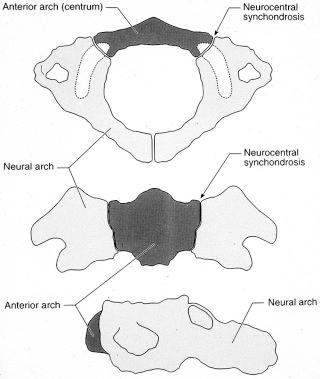
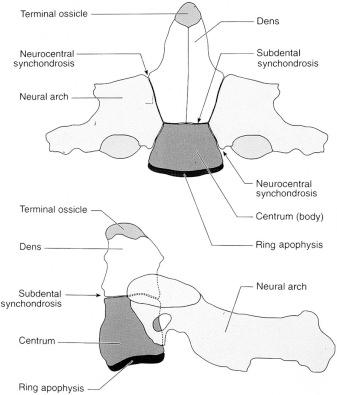
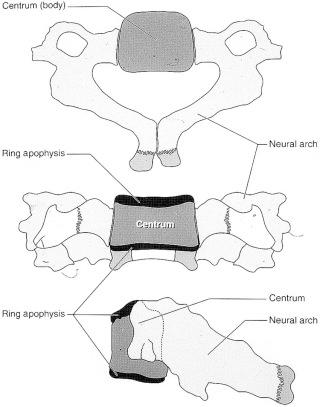
The axis develops from four primary ossification centers. The first is the body (centrum), which begins to ossify by the fifth fetal month. The dens arises from two separate ossification centers that fuse with each other by the seventh fetal month to form a single bone by birth. The dens is separated from the body by a synchondrosis that fuses between ages 3 and 6 years. Two neural arch centers form the articular pillars, pedicles, laminae, and eventually the spinous process. These generally appear by the fifth fetal month and fuse with each other by the seventh fetal month. The synchondrosis between the dens and the neural arch is present at birth and also fuses by age 3 to 6 years. The presence of this synchondrosis on a radiograph may be misinterpreted as evidence of a fracture.
The remaining cervical vertebrae (as well as those in the thoracic and lumbar regions) develop from three primary ossification centers. The ossification center of the body appears by the fifth fetal month. Bilateral centers of the neural arches that form pedicles, laminae, and eventually the spinous process appear by the seventh to ninth fetal week. The synchondrosis between the body and the neural arch fuses between ages 3 and 6 years. The synchondrosis between the spinous processes generally unites by age 2 or 3. Each vertebra also has a superior and inferior apophyseal ring along the disk margin, which appear at puberty and unite with the body at about 25 years of age. If they fail to unite, their typical rounded appearance allows them to be differentiated from a fracture. Vertebral development provides many opportunities for a large number of normal variants and anomalies to develop. Congenital malformations are common and should not be confused with injuries. These vary from minor defects such as failure of fusion of the anterior or posterior arches of the atlas to severe malformations such as vertebral fusion and hemivertebrae. In children, normal physes and ring apophyses may be mistaken for fractures; lax ligaments may produce a picture suggesting subluxation.
Cervical vertebrae with the exception of the atlas (C1) and the axis (C2) have certain common characteristics that define the “typical” vertebra: the body , which is weight bearing and located anteriorly; and the vertebral arch , which acts as a protective cover for the spinal cord and its meninges and blood vessels and which is located posteriorly. Each vertebral arch is composed of two pedicles and two laminae. The pedicles attach the arch to the vertebral body. The laminae join the pedicles and form the posterior wall of the vertebral canal, which encloses the spinal cord. The vertebral arch supports seven projections or processes: four articular processes, two transverse processes, and one spinous process. The transverse processes and spinous process serve as levers on which muscles pull. The orientation of the articular processes determines the direction and degree of motion of the vertebral column. In the cervical region, the orientation is 45 degrees, which allows maximal motion.
The cervical spine can also be divided into typical and atypical vertebrae. C3 through C6 are called typical vertebrae; C1, C2, and C7 are the atypical vertebrae. All cervical vertebrae have a common distinguishing feature—a foramen in each of the transverse processes. Typical cervical vertebrae have a vertebral body that is elliptical, being wider in its transverse diameter than in its sagittal diameter. The superoanterior surface is beveled to receive the protruding rim of the anteroinferior surface of the body above. Conversely, the posteroinferior surface of the body is concave in its sagittal direction and convex transversely to accommodate the uncinate processes of the vertebra below. On a lateral radiograph, or a sagittal CT image, the posterior margin of the vertebral body appears as a sclerotic vertical line that is uninterrupted. This is the posterior vertebral body line (posterior cortical line), an important marker of integrity of the vertebral canal. Any displacement, duplication, rotation, angulation, or absence of this line is abnormal.
Uncinate processes are not present at birth but develop during adolescence, reaching full height in the adult. They are believed to prevent lateral displacement during cervical motion. They project cranially from the upper lateral margins of the posterior aspect of the vertebral bodies. Small notches develop along the undersurface of the adjacent vertebrae at the same time.
The cervical pedicles are short and stout and arise from the posterolateral aspect of the vertebral body. They are directed posteriorly and laterally. Typically, they are notched equally on both superior and inferior surfaces.
The laminae are narrow and thin. The laminae join posteriorly to form the spinous process. On a lateral radiograph as well as on a sagittal reconstructed CT image, this junction can be recognized as a sclerotic line termed the spinolaminar line.
The superior and inferior articular processes sit on either side of a rhomboid articular pillar, often misnamed the lateral mass. Each articular process contains a facet that articulates with its neighbor. When viewed on a radiograph or sagittal reconstructed CT image, the inferior borders of the pillars overlap the superior aspect of their neighbors in an orderly manner like shingles on a roof (imbrication) .
The spinous processes are short and directed posteriorly and inferiorly. The transverse processes are short and thin and point inferiorly . This makes it possible to easily distinguish a cervical transverse process from a thoracic transverse process, which points cephalad .
All cervical vertebrae have a round transverse foramen within each transverse process. In the upper six, the vertebral artery and vein and a sympathetic nerve plexus are contained within the transverse foramen. The vertebral artery does not pass through the transverse foramen of C7.
The atlas (C1), the axis (C2), and the seventh cervical vertebra are considered atypical. The atlas differs from all other cervical vertebrae because it lacks both a body and a spinous process. There are four parts of the ring-shaped atlas: an anterior arch; a posterior arch; and the lateral masses. The anterior and posterior arches contain central tubercles on the their outer surfaces to which the anterior longitudinal ligament, the posterior longitudinal ligament, the nuchal ligament, and several muscles attach, respectively. The posterior surface of the anterior arch is slightly concave and contains in its midportion a smooth, rounded depression that articulates with the dens of C2. This is a true synovial joint with a small bursa between the bones that is frequently affected in rheumatoid arthritis. The cranial surface of the posterior arches is grooved to accommodate the vertebral artery as it courses through the transverse foramen to enter the skull.
The lateral masses of C1 represent the “body” of the atlas. The superior articular facets articulate with the occipital condyles. The inferior articular facets articulate with the superior articular surface of C2 and permit rotation of the head at the atlantoaxial joint. Anteromedially, a small tubercle projects medially from each lateral mass; this is the site for anchoring of the transverse ligament of the atlas. This ligament holds the dens in position against the anterior arch of the atlas.
The transverse processes of the atlas are the longest in the cervical region and serve as anchoring points for muscles that assist in rotation of the head.
The axis (C2), is easily recognized by a tooth-like projection (the dens or odontoid process ) that extends from the upper end of the body. The dens contains a rounded facet anteriorly for articulation with the posterior margin of the anterior arch of the atlas. Posteriorly, it is grooved to accommodate the transverse ligament of the atlas and a synovial sac. This accounts for its frequent involvement in rheumatoid arthritis. The posterior margin of the dens is a continuation of the posterior vertebral body line of C2. Under normal circumstances, this line has no interruption.
The pedicles and laminae of the axis are large. The superior and inferior articular processes actually extend above and below these areas, and a distinct pars interarticularis may be discerned. The transverse processes are short; the spinous process is also thick.
On a lateral radiograph, overlapping of the images of four distinct structures in the axis results in the appearance of a circular structure that is referred to as the Harris ring ( eFig. 4-4 ). The upper arc represents the upper margin of the superior articular facet; the posterior arc represents the posterior vertebral body line of the axis; the inferior arc represents the inferior margin of the transverse foramen; and the anterior arc represents the pedicle and anterior portion of the body of the axis. These arcs are frequently disrupted in fractures of the body of the axis. Harris' ring cannot be seen on a CT examination.
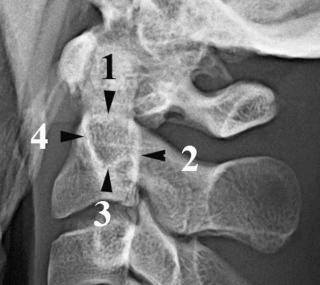
The seventh cervical vertebra is also considered atypical and is distinguished by its long, thin, nonbifid spinous process. This vertebra is further distinguished by large transverse processes that can extend as far laterally as the first thoracic transverse process. Occasionally, a cervical rib develops from the anterior root of the transverse process.
The spine can be divided into anterior and posterior components. The anterior component consists of the vertebral bodies, intervertebral disks, and anterior and posterior longitudinal ligaments. The anterior longitudinal ligament is a broad, taut structure that runs from the anterior arch of the atlas to the sacrum and is important in maintaining vertebral alignment. It is closely attached to the vertebral bodies and the annuli of the intervertebral disks. Similarly, the posterior longitudinal ligament is closely applied to the posterior aspects of the vertebral bodies and intervertebral disks. Although it is thinner overall than the anterior longitudinal ligament, it flares laterally at each disk level. The posterior component of the spine, known as the neural arch, consists of the pedicles, articular masses, apophyseal joints, laminae, spinous processes, and all intervening ligaments. The ligamentum flavum lines the dorsal aspect of the vertebral canal and is closely attached to the laminae. The interspinous ligaments interconnect the spinous processes. The supraspinous ligament connects the dorsal tips of the spinous processes contiguously from occiput to sacrum. Figure 4-1 shows these ligaments.
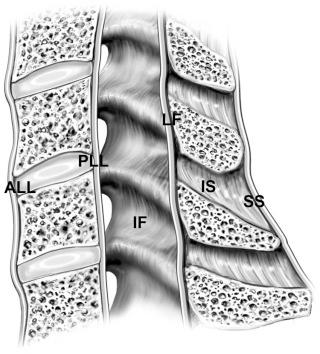
Congenital malformations and variants are common and should not be confused with injuries. These vary from minor defects such as failure of fusion of the anterior or posterior arches of the atlas to severe malformations such as vertebral fusion and hemivertebrae. In children, normal physes and ring apophyses may be mistaken for fractures. Furthermore, ligamentous laxity may produce a picture suggesting subluxation.
Most physicians who assess and treat spine injuries accept Denis's three-column concept of vertebral stability ( Fig. 4-2 ) because it is helpful in understanding the biomechanics of injury, and it is useful in the diagnosis and treatment of spine fractures and dislocations. This concept was originally described for the classification of thoracolumbar injuries but was also found to be valid for understanding cervical spine injuries. The anterior column consists of the anterior longitudinal ligament, the anterior annulus fibrosis, and the anterior two thirds of the vertebral body and intervertebral disk. The middle column consists of the posterior third of the vertebral body and intervertebral disk, the posterior annulus fibrosus, and the posterior longitudinal ligament. The posterior column consists of every structure posterior to the posterior longitudinal ligament—the posterior osseous elements (posterior arch) and posterior ligamentous complex (supraspinous ligament, interspinous ligament, facet capsule, and ligamentum flavum). The middle column is the most important and acts as a hinge or pivot between the anterior and posterior columns during flexion and extension. The presence or absence of middle-column failure helps determine the type of spinal fracture and predicts neurologic injury. Generally, spinal injuries in which the middle zone remains intact are considered stable and those in which the middle column is disrupted are unstable injuries.
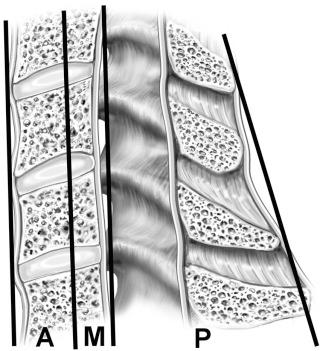
The vertebral column is further divided into functional spinal units or motion segments, defined as two contiguous vertebrae and their connecting disks and ligaments. This concept is based on the biomechanical principle that motion of any single vertebra produces some element of motion in the immediate adjacent vertebra that it shares in the motion segment. In addition, each motion segment is endowed with a certain allowable range of motion, measured in degrees in flexion, extension, and rotation about the X (coronal), Y (sagittal), and Z (axial [transverse]) axes of the body. At the atlantoaxial level, there is limited flexion and extension. However, up to 45 degrees of total rotation is permitted (22.5 degrees right and left). From C3 downward there is marked limitation of rotation but normal flexion and extension is greater. Spine injuries result when these allowable limits of motion are exceeded.
Biomechanical factors are directly linked to the unique anatomy of the affected region. For example, cervical vertebrae as a group have a greater degree of allowable motion than either thoracic or lumber vertebrae, and hence the injury patterns are different. A final consideration is the age of the patient. Older patients not only are osteopenic but also have lost much of the elasticity in their ligaments and intervertebral disks. The net result is that stresses placed on these vertebrae tend to result primarily in fractures, whereas the same forces on a child are more likely to produce a ligamentous injury.
Cervical spine injuries occur primarily from indirect forces generated by the movement of the head and trunk and are only rarely the result of a direct blow. The forces are typically multiple and complex, representing flexion, extension, axial compression, rotation, shearing, distraction, or a combination of several motion vectors. These mechanisms produce changes that can be categorized as flexion, extension, rotation, or shearing injuries. These main injury patterns are discussed separately because each of these mechanisms generates a relatively specific pattern of injuries that is important to recognize. In general, compression forces create fractures, and rotational and shearing forces disrupt ligaments.
Flexion is the most common force vector that causes spinal injury at any level. In flexion the spine bends anteriorly, pivoting about the fulcrum of the middle column. This results in compression of the anterior vertebral body and tension (posterior distraction) within the neural arch posterior to the fulcrum. It is these tensile forces that may produce ligamentous injuries and fractures of the posterior elements. The forces may be directed anteriorly or laterally. Anterior flexion forces typically involve the anterior superior vertebral body, whereas lateral forces involve the superior lateral vertebral body and the articular pillars. Flexion produces four distinct subtypes of injury: simple, burst, distraction, and dislocation.
Simple injuries involve compression of the vertebral body end plates without involvement of the posterior elements ( Fig. 4-3 ). Specifically, the posterior vertebral body line is not involved.
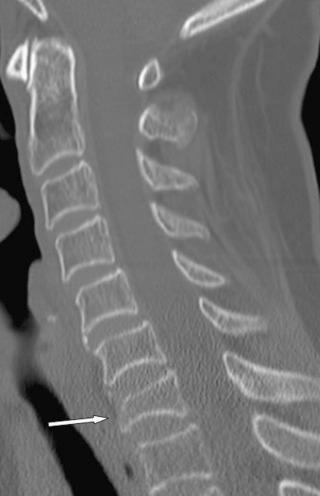
Burst fractures ( Fig. 4-4 ) are the result of severe axial compression forces applied to the vertebrae typically during flexion. As the spine is compressed, the vertebral body literally explodes, creating a comminuted fracture with involvement of the posterior wall. There is a characteristic retropulsion of bone fragments into the vertebral canal that encroaches on the thecal sac and spinal cord. In addition, the posterior elements are often involved, usually as sagittal cleavage fractures. In the cervical spine, a special variety of this type of fracture has been called a flexion teardrop fracture because of the characteristic appearance of the fragment at the anterior inferior corner of the vertebral body ( Fig. 4-5 ).
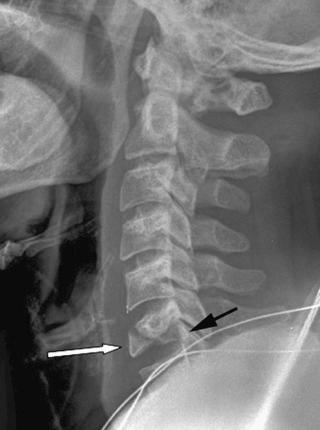
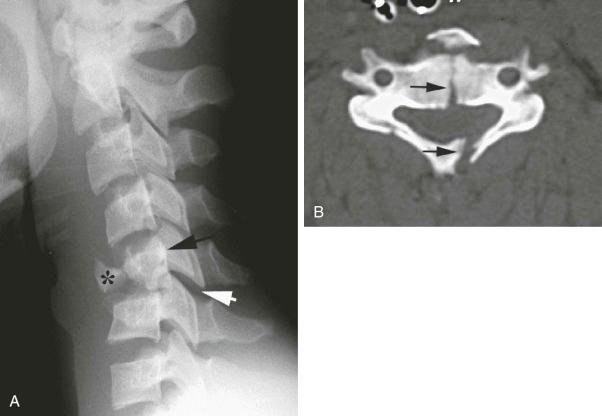
Distraction injuries refer to forces that are pulling objects apart. There are two types of distraction injuries: ligamentous/soft tissue injuries and horizontal osseous fractures. With distraction, pure ligamentous and soft tissue injury is referred to as a hyperflexion sprain . When fractures occur with this injury, they are typically small avulsion fractures. The posterior ligaments are torn along with the posterior longitudinal ligament and posterior portions of the intervertebral disk. This injury produces widening of the interlaminar and interspinous spaces, widening of the facets, and anterolisthesis ( Fig. 4-6 ). The spinolaminar line is typically disrupted. A horizontal vertebral body fracture may occur with a distraction injury and may extend out through the posterior elements. These injuries have been termed Chance-type injuries, are the result of forward flexion, and occur in the thoracolumbar region. Chance-type fractures do not occur in the cervical spine. Finally, flexion-dislocation types of injuries are the result of severe distractive forces. In the cervical spine this results in unilateral or bilateral jumped facets ( Fig. 4-7 ), depending on whether there is associated rotation (unilateral) or not (bilateral). These injuries almost always produce severe neurologic deficits.
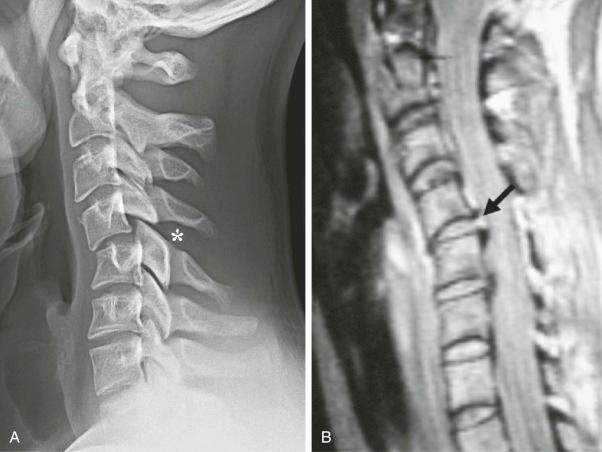
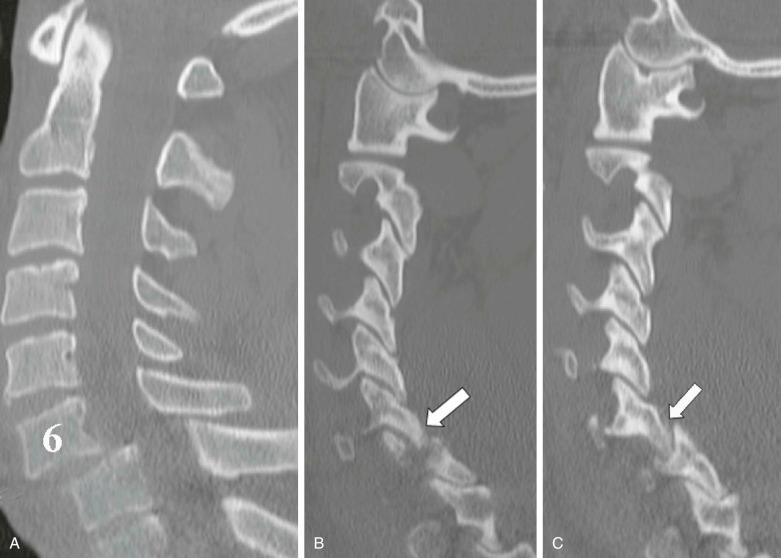
Extension is the opposite of flexion, with backward bending of the spine; the fulcrum of motion is at the level of the articular pillars. The anterior column is in tension, and the posterior column is in compression. The radiographic hallmark of extension injuries is the widening of the disk space below the level of injury . Extension forces result in tension of the anterior longitudinal ligament, which may tear at the intervertebral disk space or at the margin of the vertebral body and avulse a small fragment from the anterior superior or anterior inferior margin of the vertebral body ( Fig. 4-8 ). The compression force on the posterior elements may result in fractures of the spinous processes, facets, or laminae. The spinolaminar line, however, usually remains intact, a finding that distinguishes extension dislocations from flexion injuries in which the spinolaminar line is always disrupted. Extension forces are more common in the cervical region owing to its greater mobility.
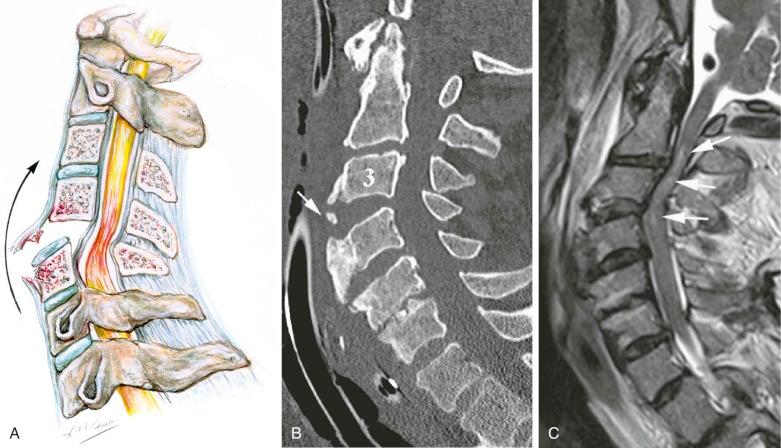
There are three subtypes of extension injury: simple, distraction, and dislocation. In simple extension injuries, an avulsion fracture occurs off of the anterosuperior portion of the vertebral body with or without minimal disk space widening. In the distraction type of extension injury, there is widening of the disk space with or without a fracture of the vertebral body. The more severe injury is the hyperextension sprain ( Fig. 4-9 ). This injury produces widening of the disk space and retrolisthesis. This injury commonly occurs in elderly patients and is associated with severe neurologic deficits, usually a central cord syndrome. Extension dislocations can occur but are rare. These injuries result in anterolisthesis and fractured articular pillars without disruption of the spinolaminar line. The dislocation may reduce spontaneously, resulting in the entity known as SCIWORA (spinal cord injury without radiographic abnormality).
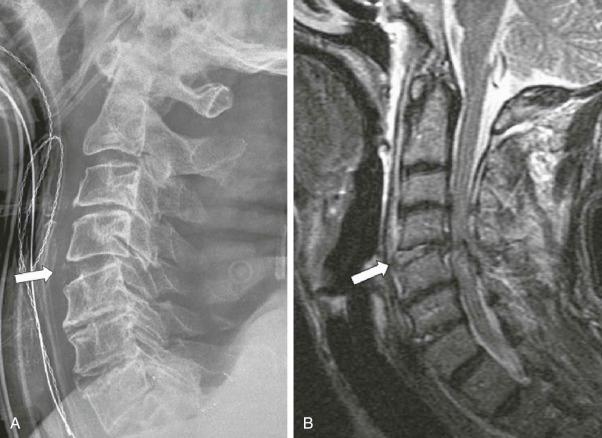
Pure rotary injuries, with one exception, do not involve the cervical spine. They typically occur at the thoracolumbar junction, where there is severe restriction to rotary motion by the facet joints. In the cervical region, rotary injuries are found as atlantoaxial rotary subluxation and rotary fixation. Rotational forces disrupt the interspinous ligaments and fracture the posterior elements. It is this force that plays a major role in fracture-dislocations of the spine. In rotational injuries, the posterior vertebral line is disrupted. An avulsion fracture can also occur from the anterior superior margin of the adjacent vertebra. Other fractures may involve include transverse processes and ribs. At CT, fragmentation and disruption of facets are common findings. In the thoracolumbar region, it is important to recognize and distinguish these injuries from burst fractures, because treatment for each injury is different.
Shearing injuries are also more common in the thoracolumbar junction region. In the cervical region, they most often occur at the craniocervical junction as occipital condyle fractures or occipitoatlantal subluxation/dislocation. Shear injuries are produced by a horizontal force applied to one portion of the spine relative to the other. This force may occur in an anterior, posterior, and/or lateral direction. Shear injuries occur when patients are struck by large objects or are ejected from motor vehicles. Thoracolumbar shearing injuries frequently result in fracture-dislocations of the spine and usually disrupt multiple ligaments. Typically, both shearing and rotational forces occur together. Such injuries have a high association with severe neurologic damage. Similar to rotational injuries, shearing injuries need to be distinguished from burst fractures, because treatment differs for each injury.
The imaging options for evaluating patients with suspected vertebral trauma include radiography, CT, and MRI. In the past, radiography was generally the first imaging study performed. However, most experts now agree that multidetector (or multislice) CT is the preferred primary imaging modality in blunt spinal trauma in adults. It has replaced radiography in most large medical centers in the United States.
Victims of trauma must be studied to determine whether they have an injured or uninjured spine. A missed cervical-spine injury can result in devastating neurologic injury. Therefore, those patients with spine injuries must be correctly identified and the injuries accurately characterized to guide treatment planning and management and to determine prognosis.
Should we image the cervical spine in all patients after trauma? Criteria for imaging the cervical spine in trauma have evolved over the past 2 decades. In 1990, Vandemark defined 10 criteria that would identify patients at high risk for cervical spine injury: high-velocity blunt trauma, generally from a motor vehicle crash; presence of multiple fractures, particularly from large bones; presence of pain, spasm, or deformity of the cervical spine; altered mental status; drowning, immersion, or diving accident; fall greater than 10 feet; head or severe facial injury; known thoracic or lumber fracture; rigid spine disease (diffuse idiopathic skeletal hyperostosis [DISH] or ankylosing spondylitis); and any conscious patient who complains of paresthesias or burning in the extremities. Only one of the indications needs to be present to indicate the patient is at high risk for cervical injury and thus requires cervical spine imaging ( eFig. 4-5 ).
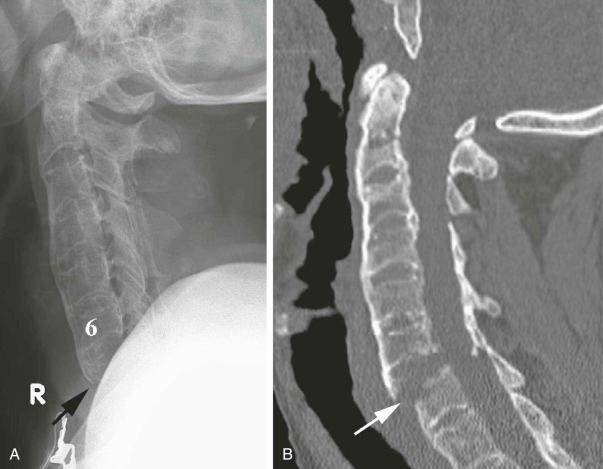
Hanson and colleagues published a different set of indications for patients to undergo helical CT using clinical parameters that would indicate a high risk for cervical injury: mechanistic factors of high speed (>35 mph); a death at the crash scene; a fall of greater than 10 feet; and clinical factors such as closed head injury; neurologic symptoms referable to the cervical region; neck pain or tenderness; and pelvic or multiple extremity fractures. Note the similarities with Vandemark's criteria. The presence of any one of these indications places the patient in a high-risk category for cervical spine injury, mandating CT of the cervical spine.
In contradistinction to the studies just mentioned, two additional studies were designed to identify factors that would indicate a low probability for cervical spine injury. The first was the National Emergency X-Radiography Utilization Study (NEXUS). This study determined that one could forego cervical imaging in patients with no midline tenderness, no focal neurologic deficits, no rmal alertness, no intoxication, and no painful distracting injuries. We refer to their results as the “5 NOs . ”
The second study led to the formulation of the “Canadian Rules” (CCR), applying to patients who are alert, oriented, and stable and who have no severe distracting injuries. These rules differentiate high-risk from low-risk factors for cervical spine injury. They used only three high-risk criteria: age over 65 years, the presence of paresthesias in the extremities, and a “dangerous mechanism of injury.” If a high-risk factor is present, imaging is recommended. If low-risk factors are present, assessment is done for motion (flexion, extension, and 45-degree rotation to either side). If motion is normal, then no imaging is recommended; otherwise, imaging is advised. If no high- or low-risk factors are present, then no imaging is recommended.
To summarize, asymptomatic trauma patients do not require imaging of the cervical spine. These patients must be neurologically intact, not intoxicated, without neck pain or midline tenderness, and with no associated severe injury, such as a pelvic or major long bone fracture, that could distract the patient. Avoidance of imaging assessment in this patient population will result in a decrease in unnecessary radiation exposure, immobilization time, and cost.
eBox 4-1 summarizes the high- and low-risk criteria from these key studies.
Altered mental status (GCS <15)
Multiple fractures
Drowning or diving accident
Significant head or facial injury
Age >65 years
“Dangerous mechanism”
Fall of >1 m
Axial load to head
High-speed MVC
MVC with large vehicle
MVC with rollover, ejection
Pedestrian struck by vehicle
Crash from motorized recreational vehicle
Paresthesias in extremities
Rigid spinal disease
Ankylosing spondylitis
DISH
Absence of high-risk factors
Low-risk factors that allow safe assessment of active range of motion (flexion/extension, 45-degree right and left rotation)
“Simple” rear-end motor vehicle collision
Sitting position in ED
Ambulatory at any time
Delayed onset of neck pain
Absence of midline cervical tenderness
Able to actively rotate neck 45 degrees left and right and to flex and extend
No midline cervical tenderness
No focal neurologic deficits
No intoxication or indication of brain injury
No painful distracting injuries
Normal alertness
DISH, Diffuse idiopathic skeletal hyperostosis; ED, emergency department; GCS, Glasgow Coma Scale; MVC, motor vehicle collision; NEXUS, National Emergency X-Radiography Utilization Study.
Until recently, radiography was the standard “screening” examination performed to evaluate patients with suspected cervical vertebral trauma. Most large trauma centers in the United States now perform CT scanning for that purpose.
One of the most dramatic changes in trauma management occurred in the past decade, when helical CT scanning was shown to be much more efficient for screening than was radiography. CT has now superseded radiography because it is easy to perform, is faster, and, most importantly, is more accurate at detecting fractures. This transition has generated several questions regarding the future of spinal radiography: Should radiography be performed at all? If so, how many views are needed? How long does the typical examination take? Is it cost effective? What about radiation dose of CT compared with radiography? What about flexion-extension radiographs?
The answer to the first question, in the opinion of the authors, is that there still is a distinct role, albeit limited, for radiography. We have found cervical radiographs useful in two situations: motion artifacts on CT studies and horizontal fractures. In the first instance, some motion artifacts can look like fractures ( eFig. 4-6 ). In the second, horizontal fractures in the plane of the scan may not always be detected. Lateral cervical radiographs alone are generally confirmatory. In addition, we find radiography useful in patients with severe cervical spondylosis, where additional correlation is needed. Finally, we also perform radiography instead of CT on children under the age of 14 years. It has been our experience that children do not suffer the same subtle types of injuries that occur in adults. Imaging studies in pediatric patients are either normal or grossly abnormal. In most instances, frontal, lateral, and open-mouth radiographs will suffice.
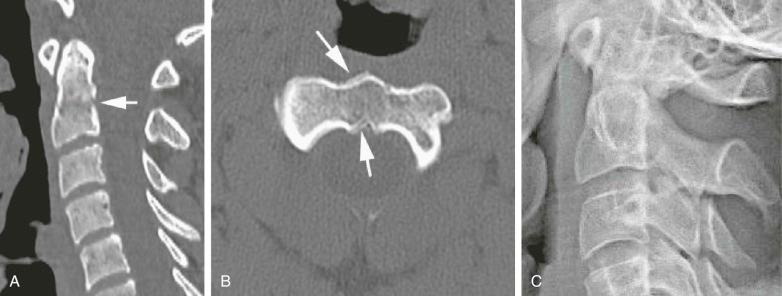
Most authorities agree that CT is far superior to radiography for identifying fractures throughout the vertebral column. This is particularly true for fractures of the pedicles, articular pillars and facets, laminae, and transverse and spinous processes. CT, however, is not infallible. In a recent study at our institution, we found that of 297 cervical fractures in 5121 patients seen over a 2-year period, radiography missed 138! CT missed two fractures, both at C2; one was horizontal, and the other was obscured by dental artifacts. Both studies were performed on a four-slice CT scanner. We have not found this problem with 64-slice or higher scanners. If an examination is obtained on a multislice machine of 16 slices or fewer, we recommended a single lateral view to supplement the CT study. Ideally, most of the outdated scanners have now been replaced.
If cervical radiography is to be performed, how many views are needed? There are many options, including the single lateral view, a three-view series (anteroposterior [AP], lateral, open-mouth), and a six-view study (adding bilateral supine oblique and swimmer views). There is now general agreement by authorities on the subject that the single lateral view is not sufficient to identify all fractures. Furthermore, the three-view series has also been found to be inadequate. Adding supine oblique views allows one to look at the articular pillars and pedicles, and often delineates the cervicothoracic junction. Unfortunately, obtaining such an extensive radiographic series is time consuming, and time is the enemy of proper trauma care. A 2000 study found that the average time for obtaining these six views was 22 minutes. Moreover, 79% of the patients required one or more views to be repeated! This results in increased radiation dose. We consider dosage issues for CT in the next section.
Flexion-extension radiographs have been used to rule out ligamentous or osseous injury to the cervical spine in patients with negative or nondiagnostic radiographs in the past. These views also may be obtained in the patient with persistent pain or tenderness in the presence of a normal CT scan. However, after acute injury to the neck, the presence of muscle spasm results in an extremely limited examination. Therefore, flexion-extension radiographs are typically of little benefit in the acutely injured patient. Certainly, they should never be performed in the unconscious patient . When there is concern for ligamentous instability and a need for prompt diagnosis, such as in a patient with a head injury, MRI is preferred, whereas occult fractures are better assessed with CT. In summary, the role of flexion-extension radiographs in the trauma patient should be limited to the follow-up of patients with persistent pain but normal initial CT studies.
As mentioned previously, there is now universal agreement that computed tomography detects more cervical spine fractures than do radiographs. Studies have shown that, compared with CT, radiography “misses” cervical spine fractures at rates of 40% to 53%, including up to one third of potentially unstable injuries. CT is far superior to radiography for identifying fractures, especially of the pedicles, pillars, and neural arches. For instance, Hanson and colleagues performed CT scans on 20 patients with cervical spine fractures seen on radiographs. CT demonstrated additional occult fractures in 50% of these patients. Besides the higher sensitivity for fractures, CT better depicts some soft tissue abnormalities such as disk herniations, soft tissue hematoma, and, occasionally, ligamentous injuries.
Multidetector CT with 1.00-mm slice thickness is used to examine the entire cervical spine in patients with known or suspected cervical spine injury based on clinical history. With multidetector technology, the entire cervical spine can be imaged in 11 seconds or less. The short scan time usually eliminates the chance of motion artifacts from swallowing, moving, or breathing. In our institutions, the data for the cervical spine is obtained at the same time the brain is scanned. Reformatted, 2D sagittal and coronal images at 1-mm intervals using a smooth enhancing algorithm help in assessing cortical detail, fractures, and alignment and should complement any trauma CT of the cervical spine. We have not found 3D volumetric reconstructions useful, except in dislocations.
CT is now the screening tool of choice for the evaluation of patients with suspected cervical injury and should be used as the primary screening tool in all high-risk patients. Bypassing the radiographic series saves valuable time, especially if the patient is already undergoing a cranial or body CT. The appropriate use of CT may improve patient outcome by rendering more accurate diagnosis; judicious initial CT also may save money during diagnoses and treatment planning in the long run. Although CT does increase radiation exposure to some patients, the reader should remember that many patients, particularly if uncooperative or intoxicated, may require numerous repeat radiographs to complete an adequate cervical spine series, increasing the overall increased radiation burden.
Is CT more cost effective than radiography for trauma screening? Cost effectiveness should be based on the actual fixed costs of the examination including the scanner, time required, supplies used, and personnel. The true cost effectiveness, however, is measured by how well a particular examination establishes the diagnosis in terms of time and accuracy. When these parameters are taken into consideration, CT has been shown to be more cost effective than radiography in the vertebral column. Furthermore, the time saved has led to faster treatment of trauma victims and better patient outcomes.
Any discussion of the advantages of CT over radiography would not be complete without considering an additional “cost” of CT: radiation exposure. CT examinations carry a higher radiation dose than radiography. However, there are new machine algorithms that decrease the exposure through lowering the milliamperage. When one considers the number of repeat radiographs needed to adequately evaluate patients with suspected vertebral injuries, as well as the efficacy of diagnosis, the higher radiation from CT may not be as significant.
Because CT is so effective in detecting injuries, it sometimes detects clinically insignificant fractures that may require only minimal symptomatic and supportive treatment. As a result, a new classification system has been devised to distinguish between those injuries requiring stabilization or other intervention and those that do not. The two categories are “major” and “minor” injuries. Major injuries are defined as having evidence of instability, with or without associated localized or central neurologic findings. Injuries that have the potential to produce neurologic compromise are considered major. Most major injuries require operative treatment. Minor injuries, on the other hand, have no imaging evidence of instability and are not associated with neurologic findings or the potential to produce neurologic compromise. They require only symptomatic and supportive treatment. Cervical injury should be classified as “major” if one of the following imaging criteria is present: displacement more than 2 mm in any plane, wide vertebral body in any plane, wide interlaminar or interspinous space, wide facet joint, disrupted posterior vertebral body line, wide disk space, burst fracture, jumped or perched facets (unilateral or bilateral), hanged-man fracture, and type III occipital condyle fracture (displacement of bone into the foramen magnum). All other types of fractures may be considered minor. eBoxes 4-2 and 4-3 show the classification of “major” and “minor” injuries.
Hyperflexion sprain
Hyperflexion dislocation
Without facet lock
With unilateral or bilateral facet lock
Comminuted (teardrop) body fracture
Burst fracture
Hyperflexion fracture-dislocation
Occipitoatlantal dislocation/subluxation
Atlantoaxial dislocation
Anterior fracture-dislocation of dens
Lateral fracture-dislocation of dens
Hanged-man fracture
Hyperextension sprain
Posterior fracture-dislocation of dens
Posterior atlantoaxial dislocation
Become a Clinical Tree membership for Full access and enjoy Unlimited articles
If you are a member. Log in here